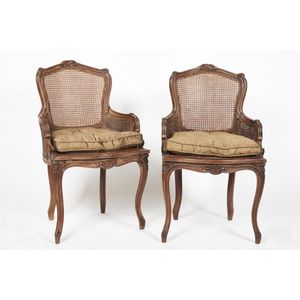Louis XV Style Cane Petite Bergeres (Pair)
Pair of Louis XV style beech and cane petites bergeres late 19th century top rails carved with flowers and scrolls, caned seats, backs and sides, raised on cabriole legs, with silk cushions (2), height 86 cm.
You must be a subscriber, and be logged in to view price and dealer details.
Subscribe Now to view actual auction price for this item
When you subscribe, you have the option of setting the currency in which to display prices to $Au, $US, $NZ or Stg.
This item has been sold, and the description, image and price are for reference purposes only.
- Cane in Furniture Making - Cane, as used to make furniture is harvested from the ratan palm. The rattan palm is a type of climbing palm that is native to tropical regions of Asia and Africa. The stem of the rattan palm, also known as cane, is harvested, stripped of its skin, and then used to make a variety of furniture items. Rattan furniture is known for its durability, lightness and natural beauty. The cane is flexible yet strong and can be woven into various patterns, making it suitable for a wide range of furniture styles from traditional to modern. The furniture made from rattan cane is also known for its durability and resistance to extreme weather conditions. Popular items include chairs, tables, sofas, and cabinets. The natural colour of the cane can be preserved or it can be stained or painted for different looks.
- Cabriole Leg - The cabriole leg evolved from an elongated scroll, curving out at the knee which may or may not be carved, and forming a serpentine shape as it descends to the foot.
First introduced into English furniture in the late 17th century, cabriole legs were widely used during the Queen Anne and early Georgian periods, where they frequently terminated in a pad foot or ball and claw foot. The style has had many imitators since then. The cabriole leg was re-introduced in the mid-19th century, and is commonly associated with the balloon-back dining or drawing-room chairs made in walnut, mahogany or, in Australia, cedar. The Victorian cabriole leg, on the whole, was rather more slender than the earlier form, following the French style, which emphasized the delicacy and daintiness of the chairs they were designed to support. Cabriole legs are sometimes found on windsor chairs, especially those made during the 18th century. - Beech - Beech, a pale coloured timber, is native to temperate Europe, Asia and North America and classified as a hardwood, although comparitively "soft" when compared with oak or ash. It has long been popular with with country craftsmen, particulary chair makers, as unlike ash it is suitable for turning.
- Scrolls - Serpentine-shaped forms, used in cabinet construction and decoration for centuries. The scroll appears in legs, feet, as carving in chair brackets, chair rails and arms. The deeper and more spontaneous the carving is, the earlier the piece is likely to be. The Regency or 'Thomas Hope' scroll, used on pediments and sideboard backs, consists of two scrolls on the horizontal plane, placed back to back in a mirror image, and sometimes decorated with a variety of carved and/or applied ornament, such as shells, foliate and other motifs. Chippendale-style furniture is often distinguished by two corresponding scrolls in the form of a 'C' in the upper splat or where chair legs join the seat rail.
This item has been included into following indexes:
-
chairs, singles / pairs / threes, style or period
- bergères (armchairs) 166
- French 949
- Louis XV 353
